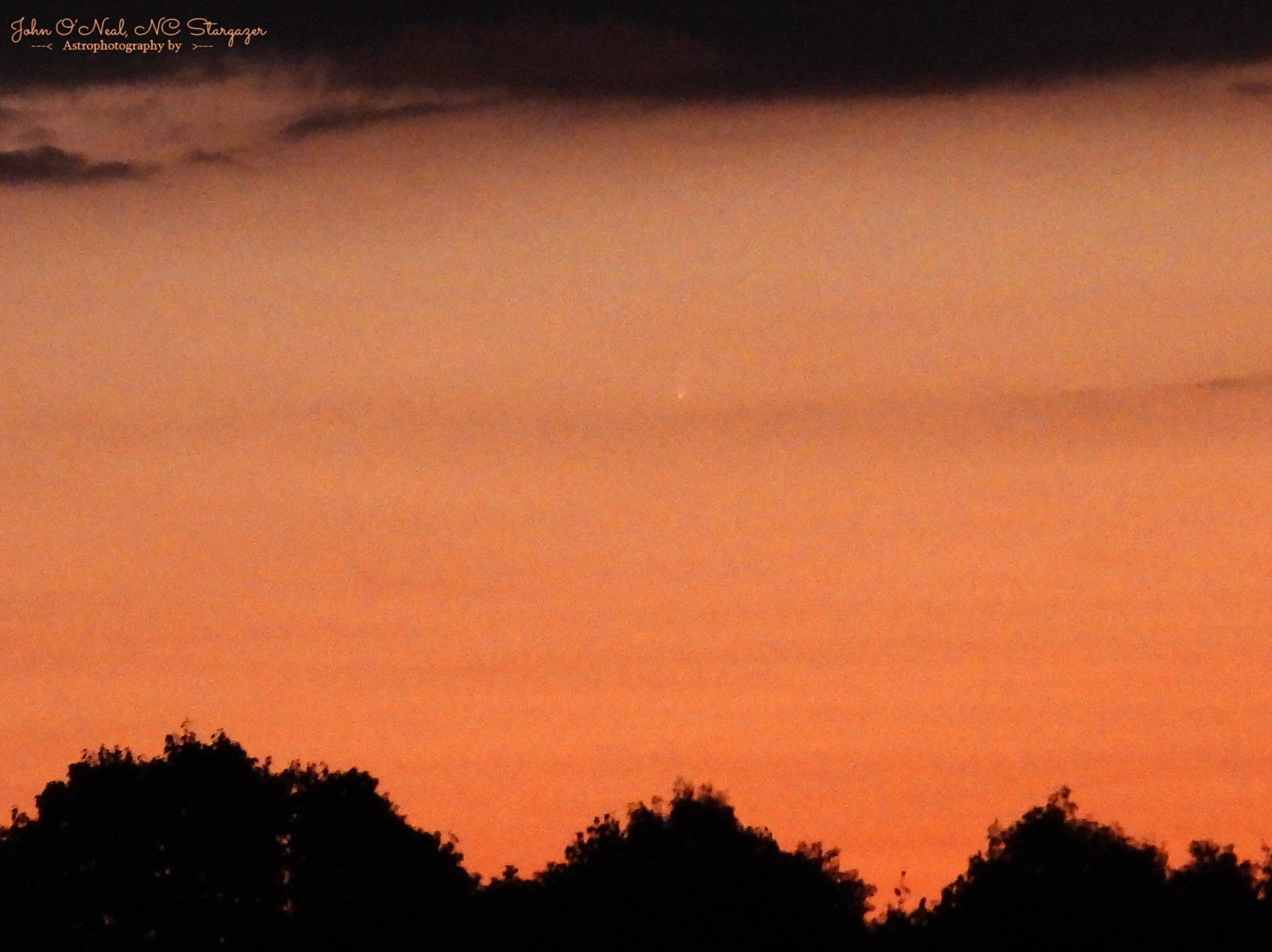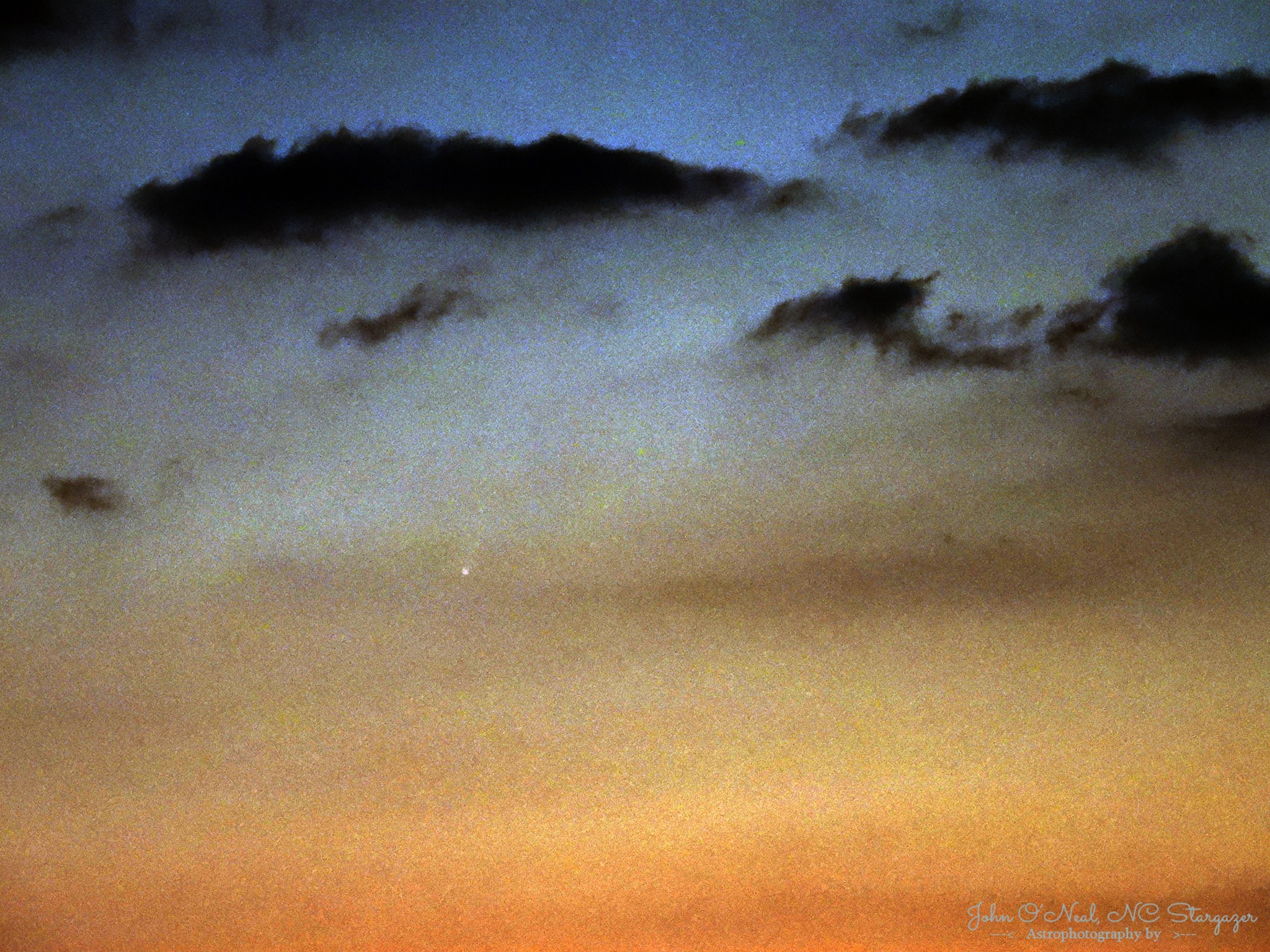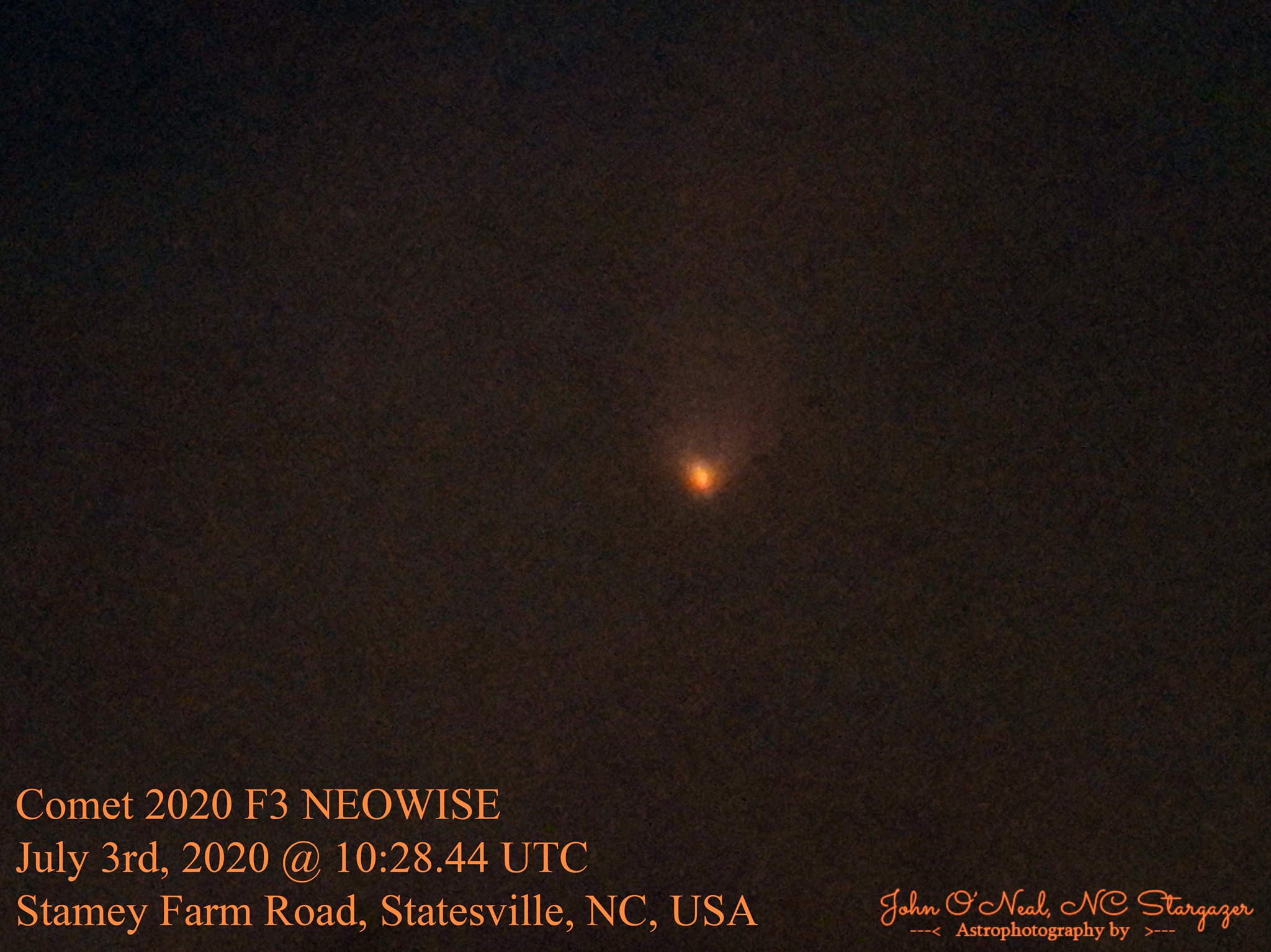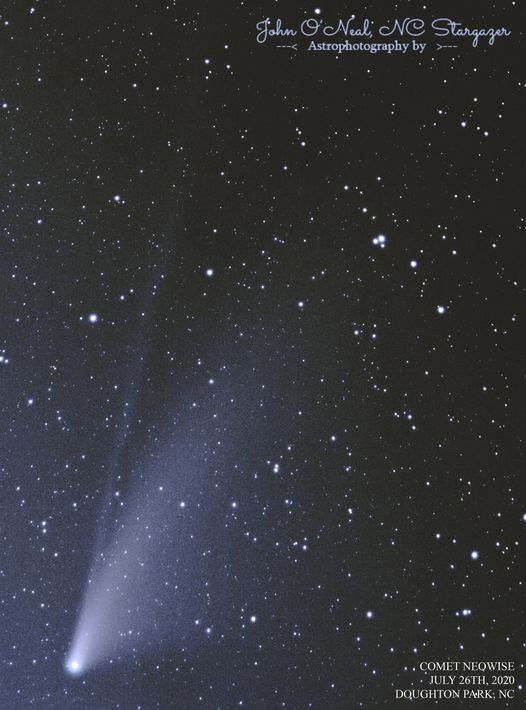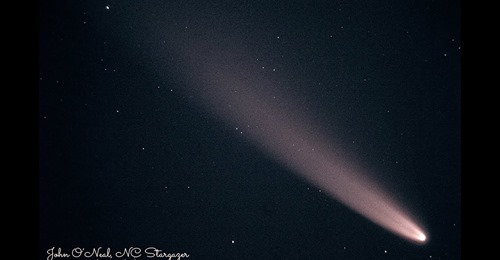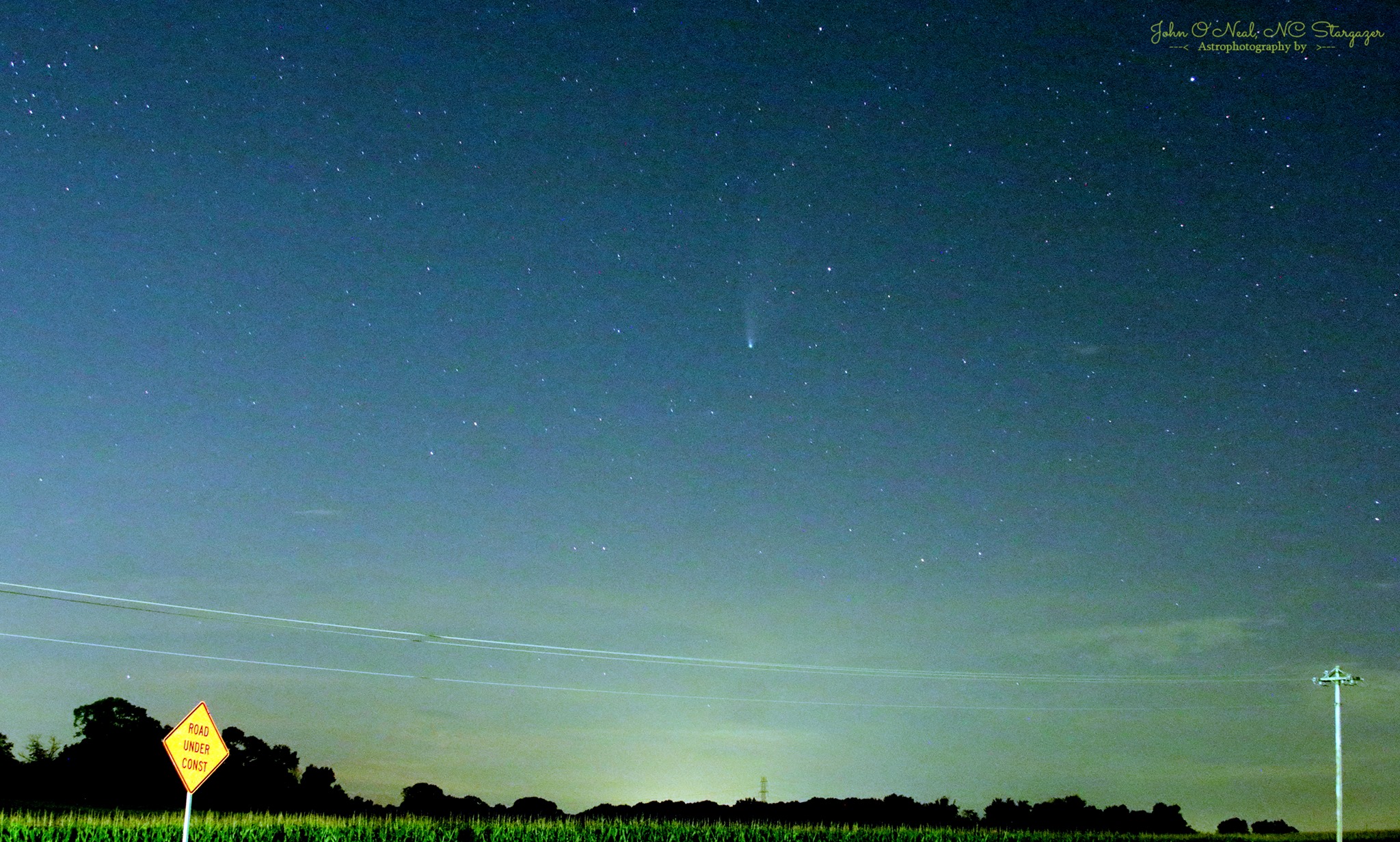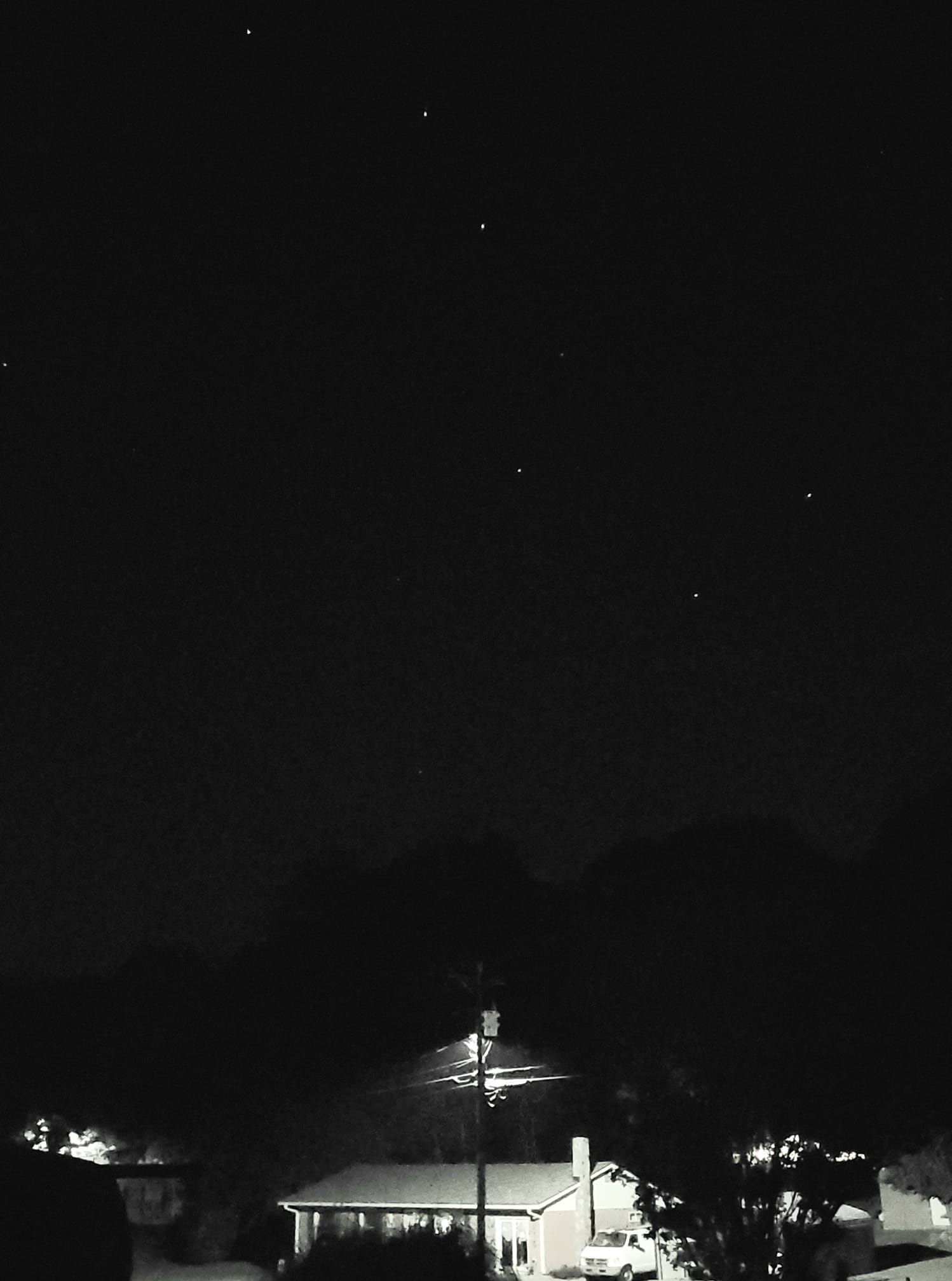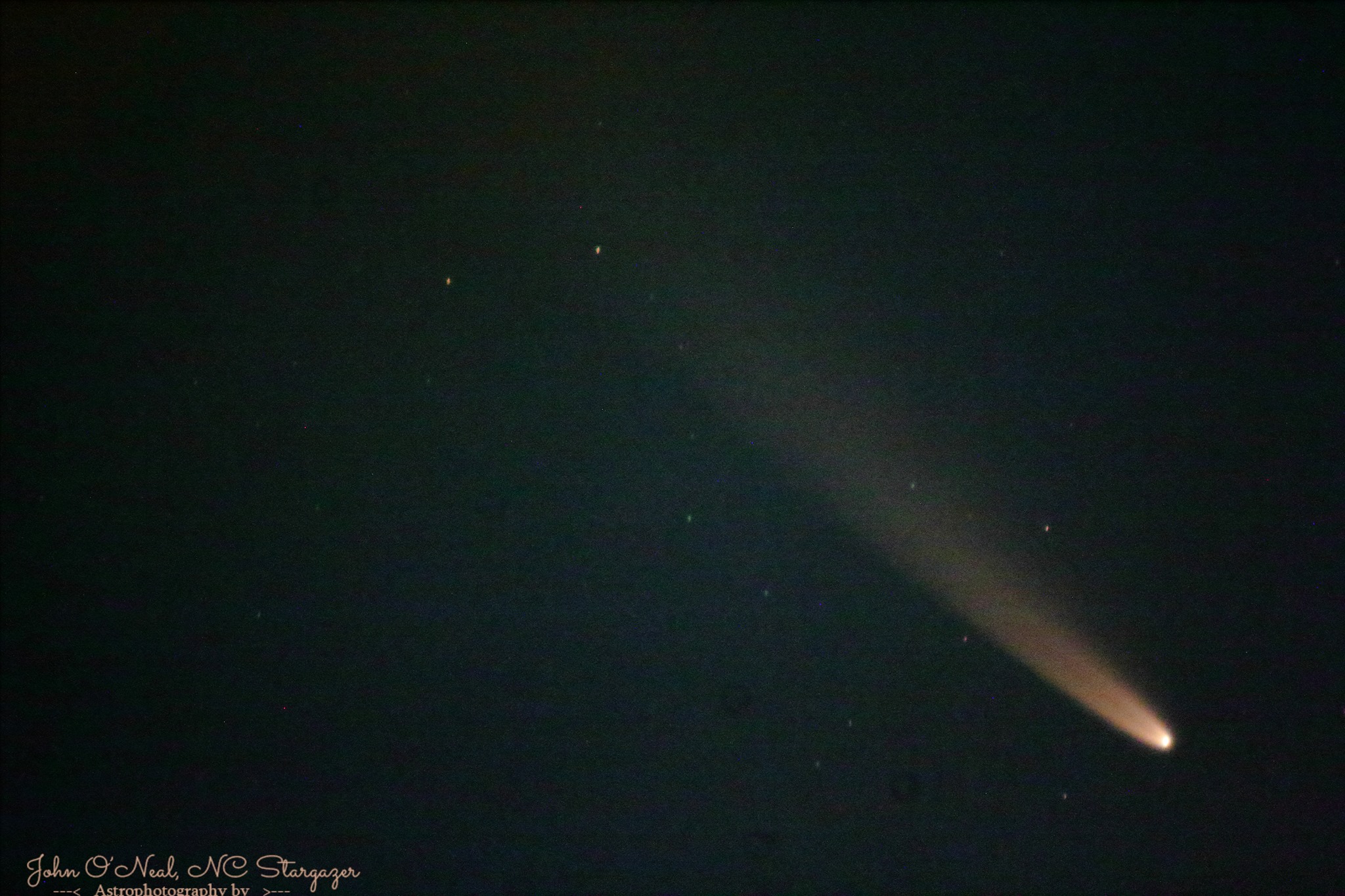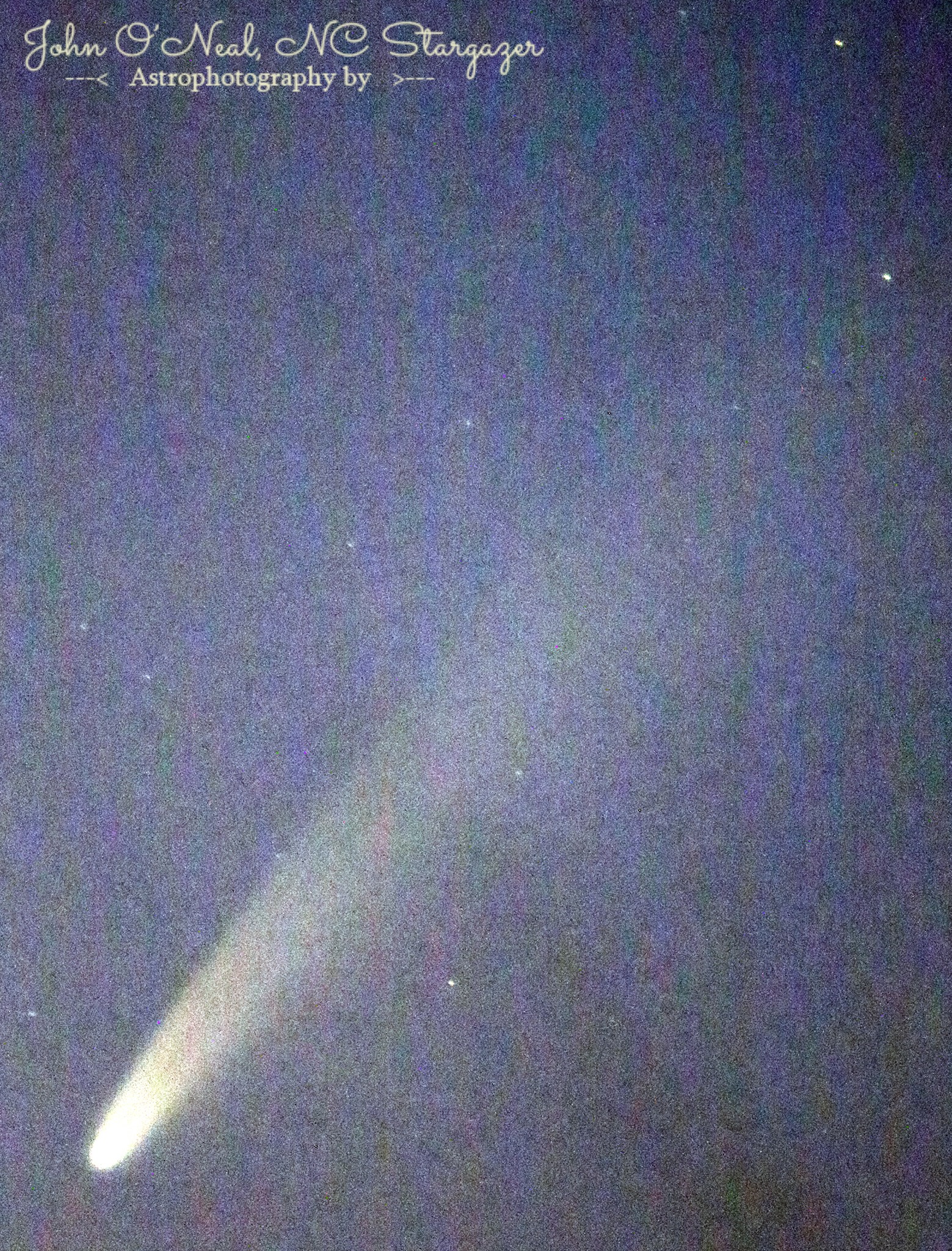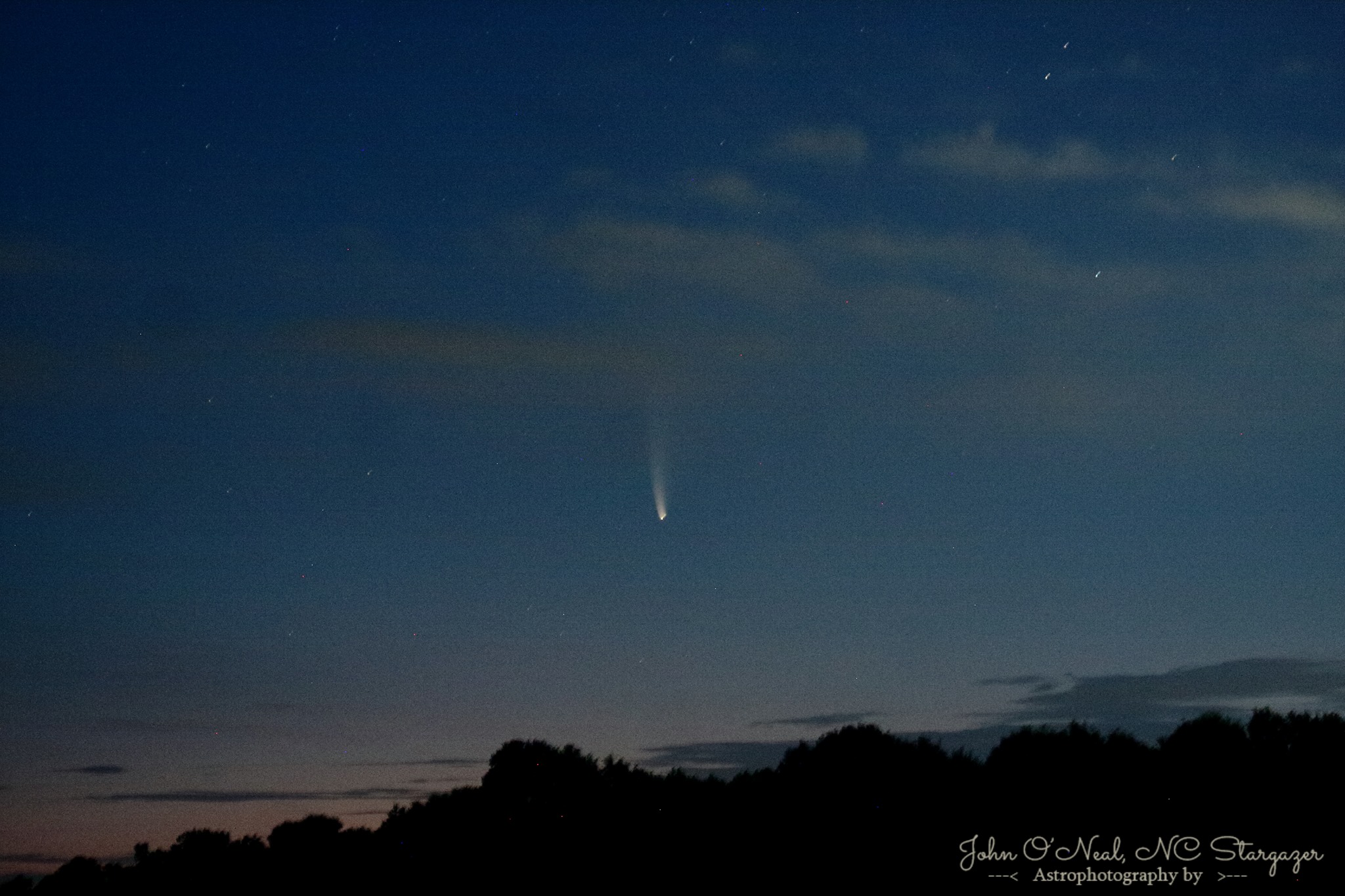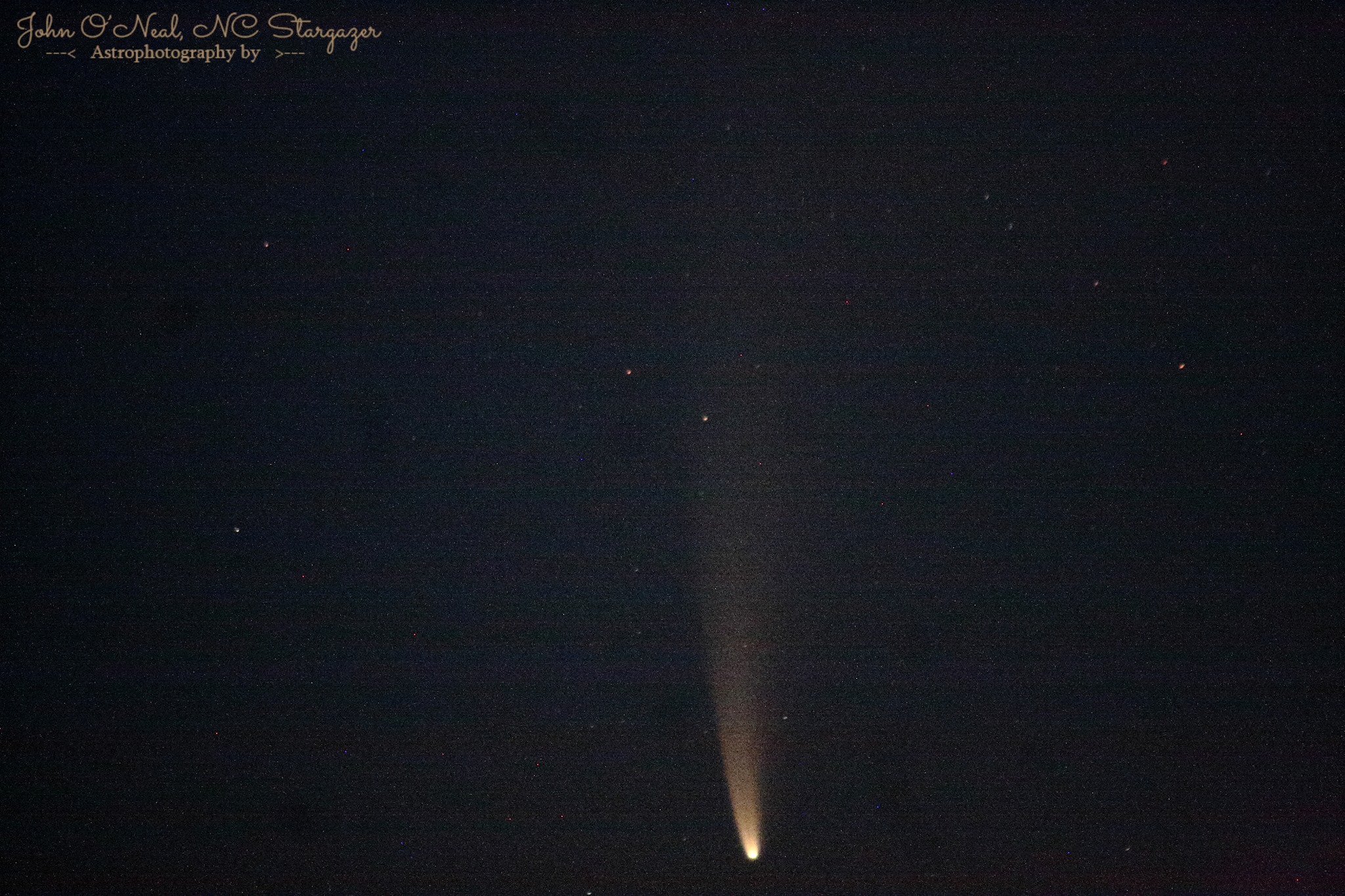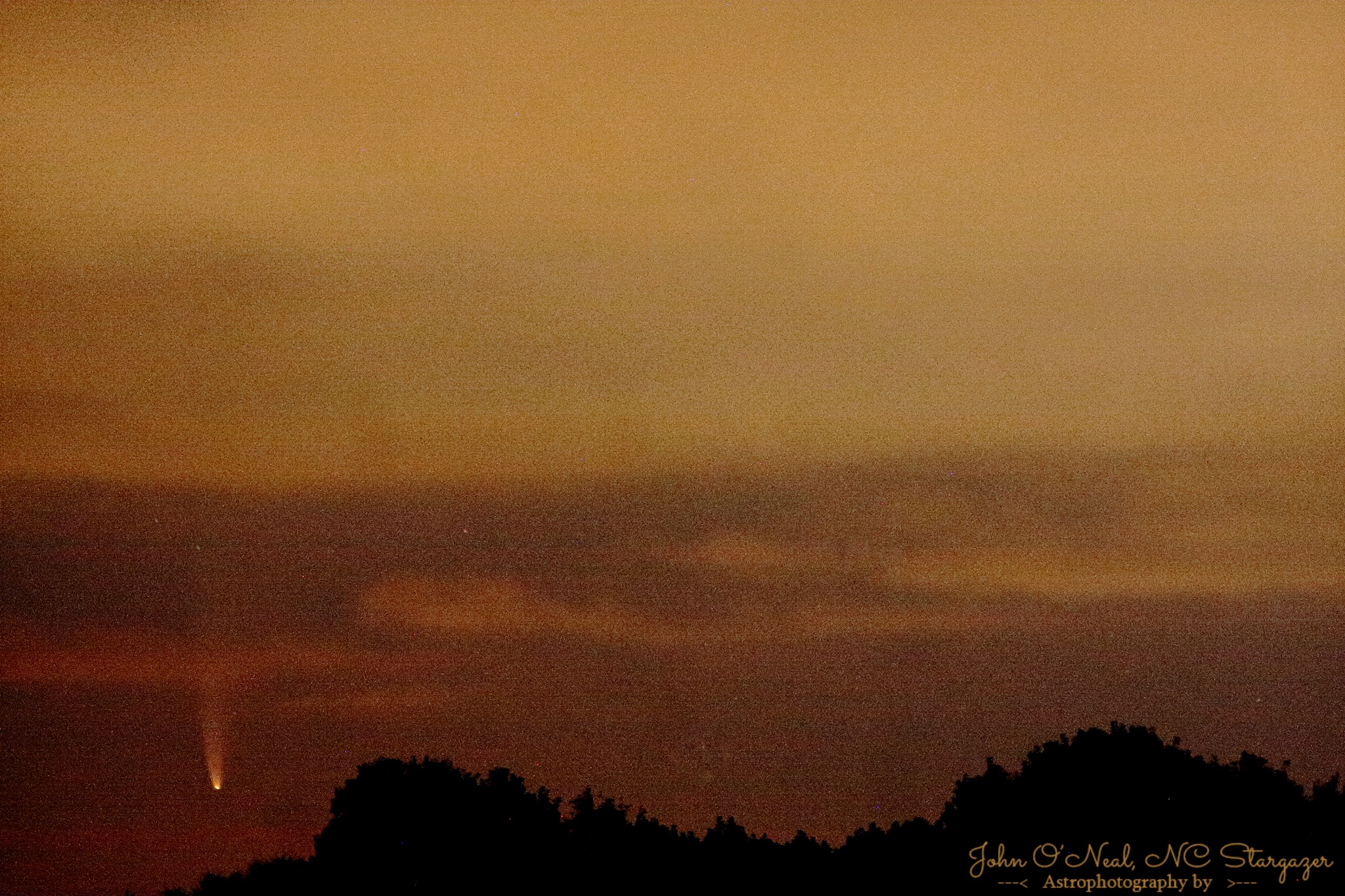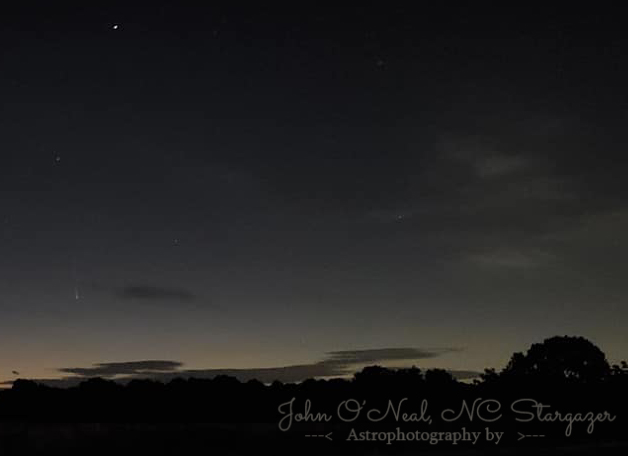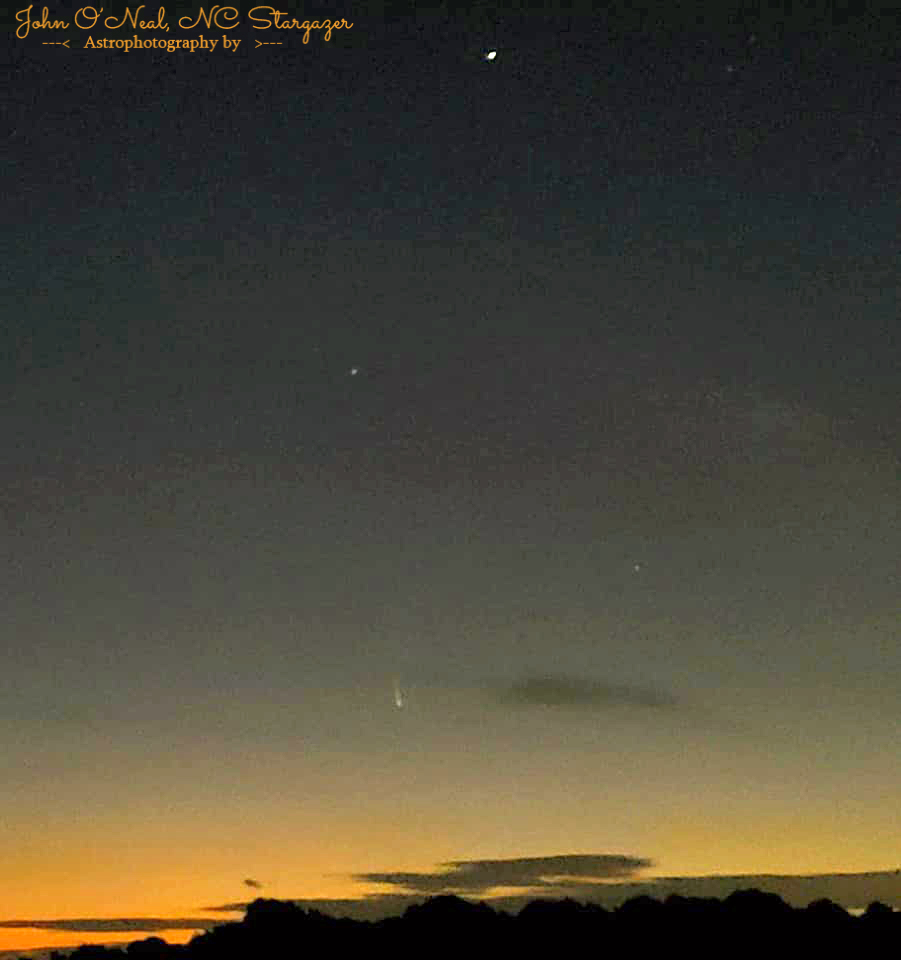C/2020
F3 or Comet NEOWISE is a long period comet with a near-parabolic orbit
discovered on March 27, 2020, by astronomers during the NEOWISE mission
of the Wide-field Infrared Survey Explorer (WISE) space telescope.
At
that time, it was an 18th-magnitude object, located 2 Atronomical Units
or 190 million miles away from the Sun and 1.7 AU or 160 million miles
away from Earth.
It's
two tails are about a million miles long and all the tail material is
stemming from a core that is only about 3 miles in diameter!
The
blue tail is called an ion tail and is formed as magnetic energy form
the sun ionizes the comet. As the ions trail off, they fluoresce in the
sunlight. Thus the blue ion tail always points away from the sun.
The
white tail is created as the comet heats up in the solar atmosphere and
material gets ejected from the body of the comet. The white tail moves
opposite the direction of travel of the comet, much like the wake of a
boat follows behind and indicates the direction of travel.
Comet
NEOWISE made its closest approach to the Sun (perihelion) on July 3,
2020, at a distance of 0.29 AU or 27 million miles. This passage
increases the comet's orbital period from about 4400 years to about
6700 years.
Its
closest approach to Earth occurred on July 23, 2020, 01:09 UT, at a
distance of 0.69 AU or 64 million miles while located in the
constellation of Ursa Major, the Big Dipper.
In
early July, the comet could be seen in the morning sky above the
north-eastern horizon and below Capella. Seen from Earth, the comet was
less than 20 degrees from the Sun between June 11 and July 9, 2020.
By
June 10, 2020, as the comet was being lost to the glare of the Sun, it
was apparent magnitude 7, when it was 0.7 AU or 65 million miles away
from Sun and 1.6 AU or 150 million miles away from Earth.
When
the comet entered the field of view of the SOHO spacecraft's LASCO C3
instrument on June 22, 2020, the comet had brightened to about
magnitude 3, when it was 0.4 AU or 37 million miles away from Sun and
1.4 AU or 130 million miles away from Earth.
By
early July, Comet NEOWISE had brightened to magnitude 1, far exceeding
the brightness attained by previous comets, C/2020 F8 (SWAN), and
C/2019 Y4 (ATLAS).
By
July, it also had developed a second tail. The first tail is blue and
made of gas and ions. There is also a red separation in the tail caused
by high amounts of sodium. The second twin tail is a golden color and
is made of dust, like the tail of Comet Hale–Bopp.
This
combination resembles comet C/2011 L4 (PANSTARRS). The comet is
brighter than C/2011 L4 (PANSTARRS), but not as bright as Hale–Bopp was
in 1997. According to the British Astronomical Association, the comet
brightened from a magnitude of about 8 at the beginning of June to −2
in early July.
This
would make it brighter than Hale–Bopp. However, as it was very near to
the Sun, it was reported as 0 or +1 magnitude and remained that bright
for only a few days. After perihelion, the comet began to fade,
dropping to magnitude 2. Its nucleus activity subdued after mid-July,
and its green coma was clearly visible after that.
On
July 13, 2020, a sodium tail was confirmed by the Planetary Science
Institute's Input/Output facility. Sodium tails have only been observed
in very bright comets such as Hale–Bopp and C/2012 S1 (ISON).
From
the infrared signature, the diameter of the comet nucleus is estimated
to be approximately 5 km or 3 miles. The nucleus is similar in size to
Comet Hyakutake and many short-period comets such as 2P/Encke,
7P/Pons-Winnecke, 8P/Tuttle, 14P/Wolf, and 19P/Borrelly.
By
July 5, NASA's Parker Solar Probe had captured an image of the comet,
from which astronomers also estimated the diameter of the comet nucleus
at approximately 5 km (3 miles
Later in July 2020, other observations were also reported, including those related to coma morphology and sodium emissions.
Attached
are some images I shot of the comet over the last month, starting with
morning shots from a remote site on the outskirts of Statesville, North
Carolina and ending with some shots on a recent trip to Doughton Park
on the Blue Ridge Parkway to image the comet under dark night skies.
Check my 7.5 minute video of
Dorothy O'Neal
,
Ronnie Sherrill
,
Tim Slay
,
Chuck Adams
and I as we journey around North Carolina capturing images of and celebrating Comet 2020F3, NEOWISE. Sorry,
Tom Robarge
, I didn't get any images of you but wanted to give you a shout out!!!
out
Comet ATLAS, C/2020 M3 in Orion last night, November 18th, 2020

Here's my 1.5 hour stack of Comet 2020/F3, NEOWISE. Shot July 26th, 2020 from 22:06-23:36 EST.
Canon 60Da w/75/300mm Zoon at f/4.5 7nmm on my iOptron IEQ30 GEM Mount. 180 x 30 second subs at 1,600iso.
Captured w/BACKYARD EOS, stacked in Deep Sky Stacker and processed in Adobe Photoshop CS6.
Was fighting dust & haze in the atmosphere being illuminated by a first quarter Moon.
Yesterday morning,
Ronnie Sherrill
,
Tim Slay
and I went to "Comet Central" on Stamey Farm Road in Statesville, NC to image Comet 2020 F3, NEOWISE.
I
brought along my Astro-Tech 8" Imaging Newtonian Reflector and placed
my Canon 60Da at prime focus, yielding an 800mm f/4 lens. As a result I
was not able to capture the entirety of the comet's length.
I
was shooting continuously for 45 minutes, from 4:48 am when the comet
became visible until 5:33 when the sky was too bright to see the comet.
Here's a video. If you view it full screen you can see the dust in the sky blowing around.
https://www.youtube.com/watch?v=aNqdpjR1D2U&feature=youtu.be&fbclid=IwAR0hiZlS7u1mm9G2Re5WoVwuoxwcl5mN6cdASTGnTp1JVR4Jv6OvvFuvWhI
Is it time for another great comet yet?
126 x 30 second images at 1600iso. Canon 60Da & Canon lens at 75mm focal length
Camera mounted on an iOptron IEQ30. Images captured using BACKYARD EOS.
Shot at Doughton Park Picnic area along the Blue Ridge Parkway in Laurel Springs, North Carolina. About 4,000 feet elevation
comet Neowise. Shot in August of this year
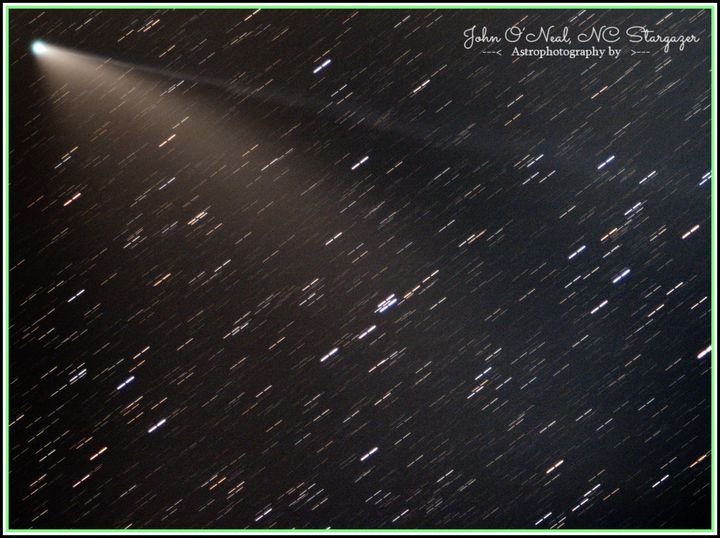 Watch Comet NEOWISE 2020 F3 setting in the North Western Sky at Doughton Park on July 14th, 2020.
Watch Comet NEOWISE 2020 F3 setting in the North Western Sky at Doughton Park on July 14th, 2020.
https://www.youtube.com/watch?v=DLZgQrWtB98&feature=youtu.be&fbclid=IwAR14VCfXP6ifJbLhF0rIA_X205LPftwvs08yKyKQik_h3cecjnCdvotdxAE
Comet Central tonight. It finally cleared up, but the sky was terribly ugly.....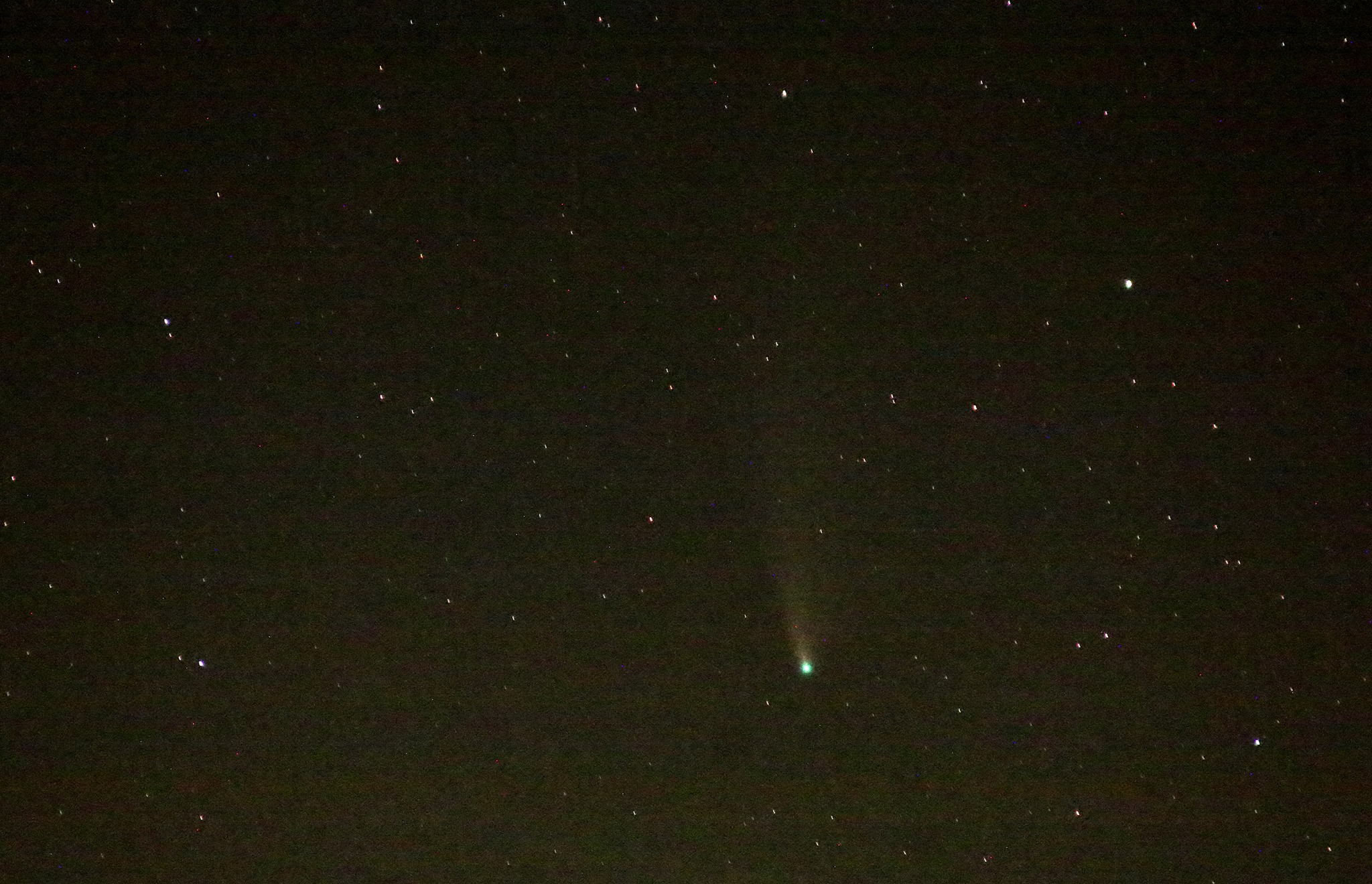
Starting tomorrow night I can stay home and observe the comet from my observatory...
I
shot this when we got home at 11:30, and realized that the comet had
just set behind the trees, giving me abiut 2 hours of comet before it
sets without leaving the house!!!!
My first timed image using a German Equatorial Mount for tracking.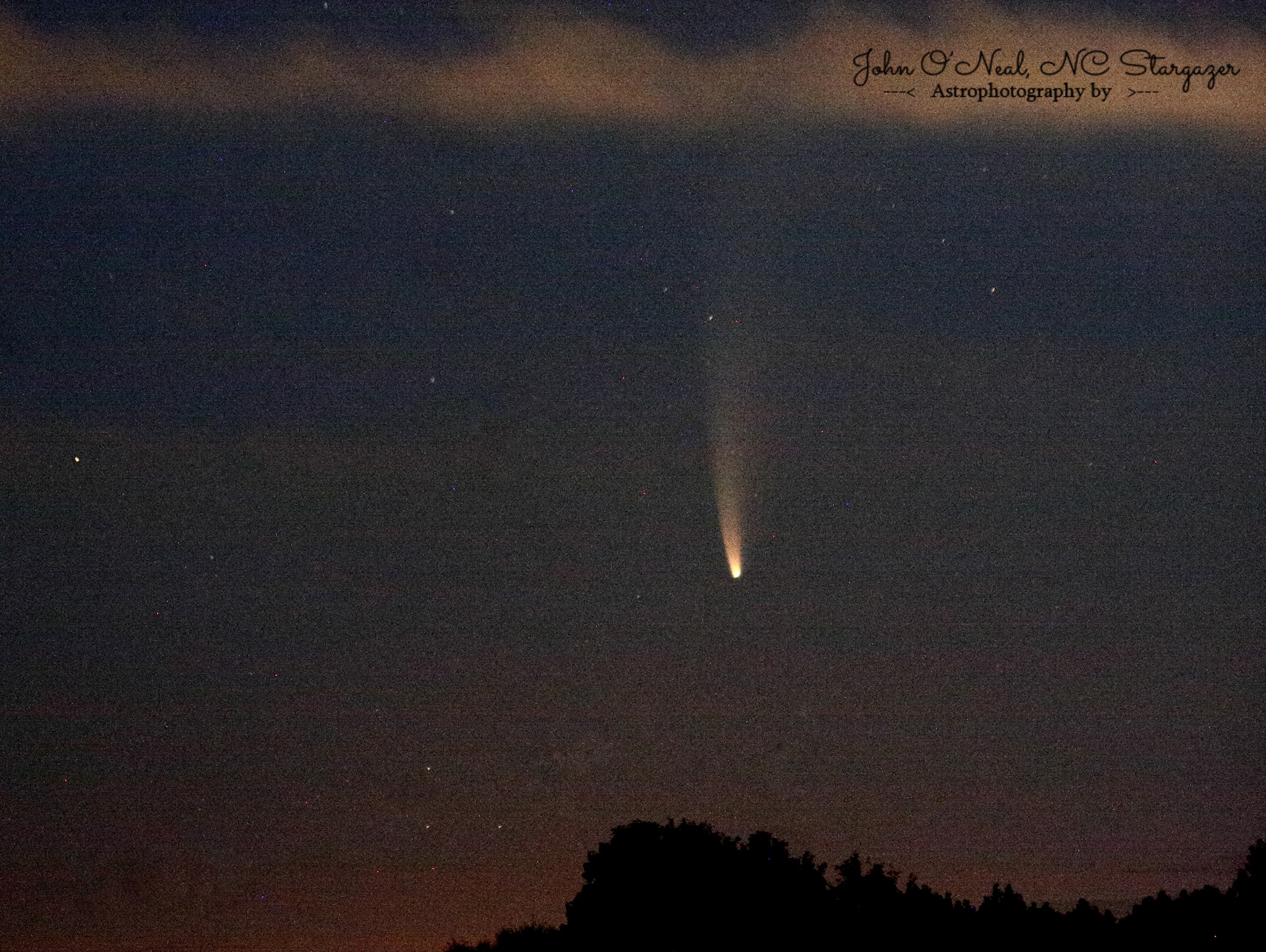
First
view this morning. I couldn't believe it when I spotted the comet in
binoculars underneath a large cloudbank hovering just a few degrees
above the treetops...
Capella and a couple of other stars in the morning sky with Comet NEOWISE.
My second ever comet image with a smartphone!!!My first with a selfie with a comet behind me!!!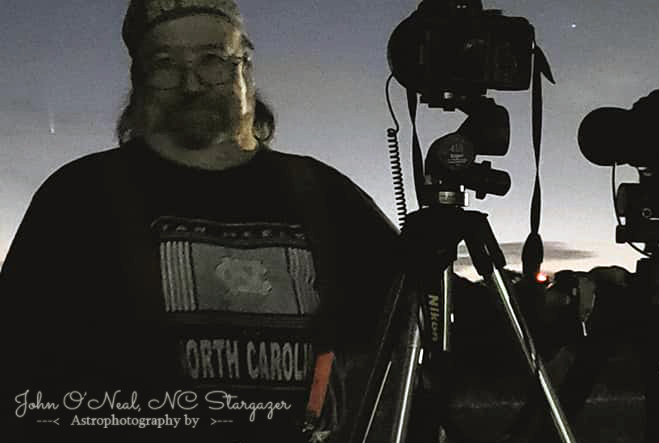
After 50 years of imaging comets, this is my first with a smartphone!!!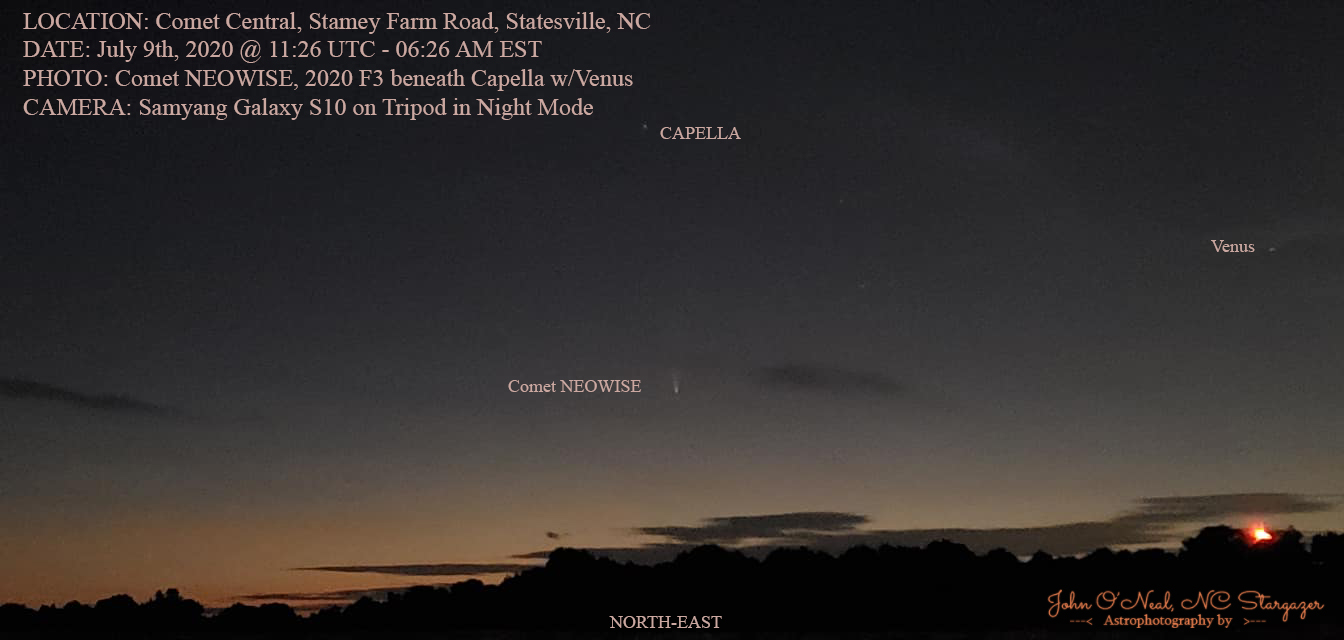
The
Comet was quite spectacular this morning. I caught it as soon as it
appeared on the horizon. The sky was the clearest I've seen since
starting to watch the comet. Easily spotted in binoculars as well as
naked eye visible once I knew where to look.
I had 4 cameras running...
The 60Da was on the iOptron IEQ30 with the 500mm mirror lens.
The 40D was on the Orion Paragon Tripod with the 75-300mm Canon lens, being utilized at various focal lengths.
The Nikon P1000 was on the Bogen Manfrotto, also shooting at various focal lengths.
The Samsung Galaxt S10 was on it's little tripod shooting the comet and the action going on at Comet Central this morning.
It
looks like an Ion tail is beginning to form. It will become more
evident as the comet continues away from the sun and the tail swings to
a more perpendicular view from our perspective.
I think this is going to be a nice comet when it reaches evening twilight.
We might have to make a trip to the mountains this weekend... Stay tuned for updates!!!
The
Comet was quite spectacular this morning. I caught it as soon as it
appeared on the horizon. The sky was the clearest I've seen since
starting to watch the comet. Easily spotted in binoculars as well as
naked eye visible once I knew where to look.
I had 4 cameras running...
The 60Da was on the iOptron IEQ30 with the 500mm mirror lens.
The 40D was on the Orion Paragon Tripod with the 75-300mm Canon lens, being utilized at various focal lengths.
The Nikon P1000 was on the Bogen Manfrotto, also shooting at various focal lengths.
The Samsung Galaxt S10 was on it's little tripod shooting the comet and the action going on at Comet Central this morning.
It
looks like an Ion tail is beginning to form. It will become more
evident as the comet continues away from the sun and the tail swings to
a more perpendicular view from our perspective.
I think this is going to be a nice comet when it reaches evening twilight.
We might have to make a trip to the mountains this weekend... Stay tuned for updates!!!
